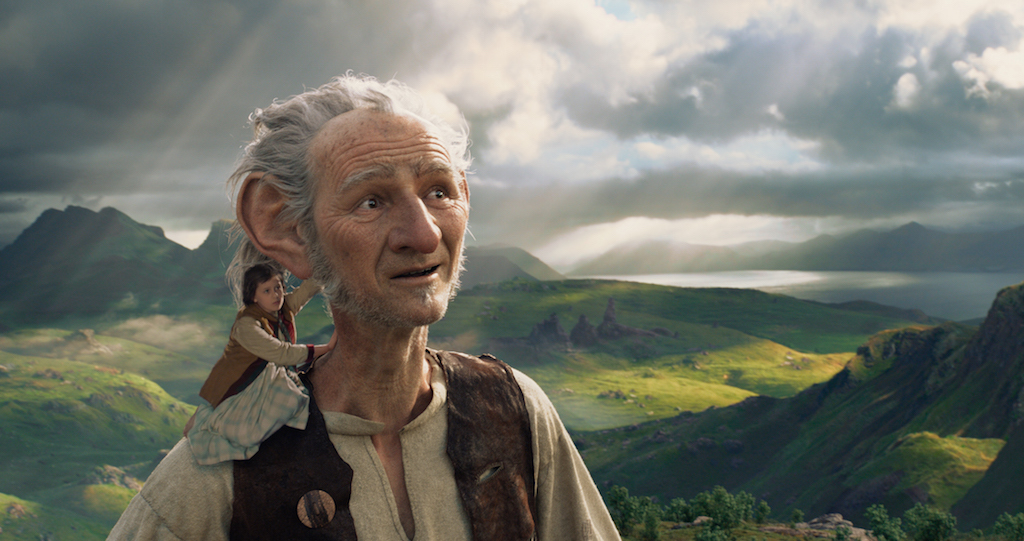
The Big, Friendly Giant at the center of Steven Spielberg’s The BFG (yes, the “F” stands for “Friendly”—get your minds out of the gutter, people!) is a truly wondrous creation: He is enormous, of course, but skinny—all pointy elbows and knobby knees. He has the elongated proboscis befitting a giant, plus ears that suggest he is capable of taking flight, and wild tufts of white mad-scientist hair. When he speaks, his words are fanciful and funny—he turns malaprops into a kind of silly poetry. But it’s his eyes—partly created by the CGI wizards at Disney and partly created by actor Mark Rylance—that tell the whole story: They are warm and wistful and seem to contain both a kind of childlike innocence and the wisdom of the ages.
The other giants populating the faraway Giant Country where the BFG lives are all considerably larger than he is—they can pick him up and toss him like a rag doll—and not nearly as lovable. They are a rogue’s gallery of villains, with shrunken heads and bulbous noses and snaggle-teeth. Much like the dinosaurs in Spielberg’s Jurassic Park, their largeness feels palpable, corporeal. They are both frightening (they eat children!) and, befitting villains in a children’s story, a little ridiculous.
All of this works wonderfully, as does the charming workshop where the BFG lives and collects glowy dreams in jars, to be distributed to humans via a trumpet-like funnel late at night. And because the BFG doesn’t eat children, it’s here where he we see the icky oozy “snozzcumber” vegetables he cooks and the fizzy “frobscottle” juice he drinks (causing massive farts, or “whizpoppers” as the BFG calls them). Everything in the cabin is giant-sized, except for a few small nooks he has created for child visitors. Here, Spielberg has created the kind of richly imaginative and painstakingly detailed set that brings the pages of a book to life.
With all of this, I wish I could recommend The BFG more whole-heartedly. But you see, the film’s flaw lies with its child heroine, Sophie (Ruby Barnhill). There’s nothing wrong with the actress—she’s perhaps not as moppet-cute as most child stars, but that’s to the film’s credit. She seems serious and a bit bookish, especially when she peers at the world behind a pair of oversized pale orange glasses. (Warby Parker?) The problem with Sophie is that we never really get to know her. She’s snatched by the BFG from her own bed in the orphanage where she lives. At this point, all we’ve learned about her is that she has insomnia, likes to stalk the orphanage at the “witching hour,” enjoys books and cats, and that, on the night she’s abducted, she scolds a pack of marauding drunks who loudly stumble out of the bar near the orphanage. (The drunks didn’t seem to serve any purpose other than to possibly suggest that the whole film is Sophie’s dream—the drunks would be stand-ins for the evil giants—although if that’s true, there’s no further evidence to support it.)
While peering out the window, she sees the BFG distributing his dreams and he sees that she sees him, so he has no choice but to take her back to Giant Country. She’s (mildly) afraid at first, but quickly takes to the BFG (they go out and gaze at the stars and collect dreams together) and never wants to leave. But…why? For a film preoccupied with dreams, we never fully understand Sophie’s dreams. We know nothing about her life at the orphanage—or before the orphanage, if she had one. We never see her pining away for a family, or itching for adventure. She seems smart and capable and inquisitive—but that’s about it. This is particularly surprising considering the great success Spielberg has had directing children in the past. He usually has a way of making children interesting—and teasing out their innermost hopes and fears and desires in an utterly non-patronizing way. Not the case here.
In fact, Sophie’s not the only human character who gets short shrift. Eventually, Sophie and the BFG travel to Buckingham Palace and meet the queen (a wonderful Penelope Wilton, of Downton Abbey fame). This is a silly, kid-approved sequence, involving farting corgis and toppled chandeliers. But there is also a woman who works for the queen (Rebecca Hall), who I think is presented as a possible mother figure for Sophie. Except we know nothing about her, and she and Sophie barely even speak. (Was the rest of Hall’s part left on the cutting room floor?)
Some of these shortcomings, I imagine, are baked into Roald Dahl’s short story, which I haven’t read. But there is no rule that says you can’t embellish the story to make it more viable for film. It really wouldn’t have taken much to give Sophie a more vivid inner life or to get us more invested in her future.
The BFG does a bang-up job with its titular hero—and for that alone, I can recommend it. I simply wish its human heroine had been treated with similar care.
